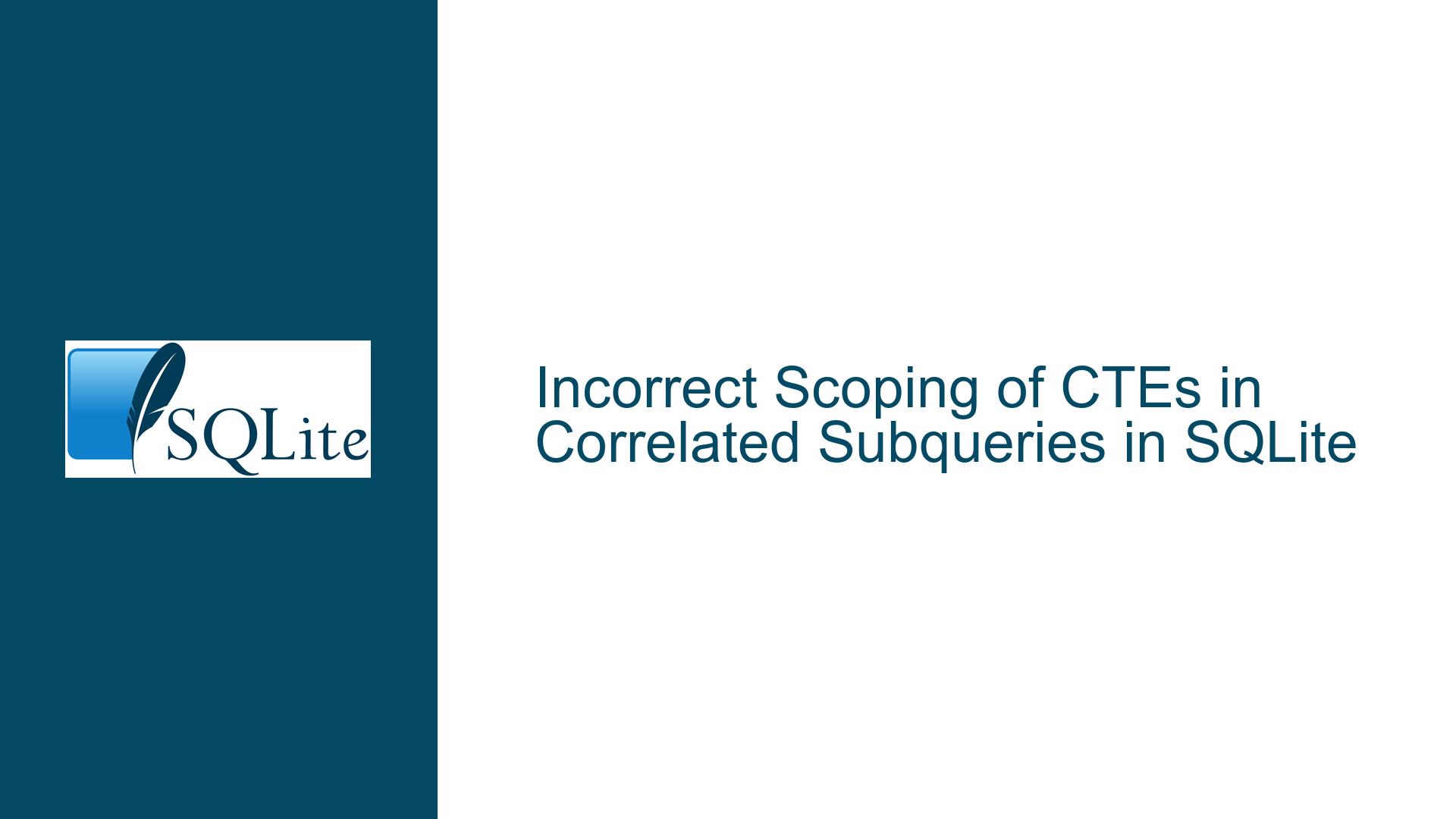Incorrect Scoping of CTEs in Correlated Subqueries in SQLite
Issue Overview: CTE Scoping and Correlated Subquery Behavior in SQLite
The core issue revolves around the incorrect scoping of Common Table Expressions (CTEs) when used in correlated subqueries in SQLite. Specifically, the problem arises when a CTE references a column from an outer query, and this reference is incorrectly interpreted as belonging to an inner query binding. This behavior leads to unexpected query results, particularly when column names are shadowed or reused in nested queries.
To understand the issue, let’s break down the problematic query structure. Consider the following example:
CREATE TABLE tbl(id INTEGER NOT NULL PRIMARY KEY);
INSERT INTO tbl VALUES (1), (2), (3);
WITH cte AS (SELECT t.id)
SELECT (SELECT id FROM cte)
FROM tbl t;
In this query, the CTE cte is defined as SELECT t.id, where t.id is expected to refer to the id column from the outer query’s tbl t. However, SQLite incorrectly allows this reference, even though t.id should not be visible within the CTE’s scope. This behavior becomes more problematic when shadowing occurs, as demonstrated in the second example:
SELECT t.id,
(WITH cte AS (SELECT t.id)
SELECT t.id
FROM tbl t
WHERE t.id IN (SELECT id FROM cte))
FROM tbl t;
Here, the inner query redefines tbl t, which should logically shadow the outer tbl t. However, SQLite incorrectly interprets the reference to t.id within the CTE as belonging to the inner query’s tbl t, leading to the following incorrect output:
1|1
2|1
3|1
The expected behavior is that the reference to t.id in the CTE should refer to the outer query’s tbl t, but SQLite’s scoping rules fail to enforce this, resulting in incorrect query results.
Possible Causes: Misinterpretation of Scoping Rules and Shadowing in Nested Queries
The root cause of this issue lies in SQLite’s handling of scoping rules for CTEs and correlated subqueries. SQLite’s scoping rules are designed to ensure that column references are resolved correctly within nested queries, but in this case, they fail to properly handle references within CTEs when used in correlated subqueries.
One possible cause is that SQLite’s parser does not correctly enforce the visibility of outer query columns within CTEs. In standard SQL, a CTE should only be able to reference columns from its own definition or from tables explicitly joined within the CTE. However, SQLite appears to allow references to columns from outer queries within CTEs, which violates this principle.
Another contributing factor is the way SQLite handles shadowing in nested queries. When a table or column is redefined in an inner query, it should logically shadow the outer definition. However, in the case of CTEs, SQLite seems to incorrectly resolve references to the inner query’s definition, even when the reference is made within the CTE. This behavior suggests a flaw in SQLite’s name resolution algorithm, particularly when dealing with nested queries and CTEs.
Additionally, the issue may be exacerbated by SQLite’s lack of strict type checking and scoping enforcement. Unlike some other databases, SQLite is known for its flexibility and permissiveness, which can sometimes lead to unexpected behavior when queries are not written with strict adherence to standard SQL practices. This flexibility, while useful in many cases, can result in subtle bugs like the one described here.
Troubleshooting Steps, Solutions & Fixes: Addressing CTE Scoping and Shadowing Issues
To address the issue of incorrect CTE scoping and shadowing in SQLite, several steps can be taken to diagnose, troubleshoot, and resolve the problem. These steps include understanding the expected behavior, identifying workarounds, and considering long-term solutions.
Understanding Expected Behavior
The first step in troubleshooting this issue is to understand the expected behavior according to standard SQL. In standard SQL, a CTE should only be able to reference columns from its own definition or from tables explicitly joined within the CTE. References to columns from outer queries should not be allowed within the CTE’s definition. This ensures that CTEs are self-contained and do not inadvertently depend on external context.
In the case of correlated subqueries, the expected behavior is that references to columns from outer queries should be resolved correctly, even when shadowing occurs. For example, if a table is redefined in an inner query, references to that table within the inner query should refer to the inner definition, while references in the outer query should refer to the outer definition.
Identifying Workarounds
Given SQLite’s current behavior, one workaround is to avoid referencing outer query columns within CTEs. Instead, explicitly join the necessary tables within the CTE to ensure that all references are resolved correctly. For example, the problematic query can be rewritten as follows:
SELECT t.id,
(WITH cte AS (SELECT t2.id FROM tbl t2 WHERE t2.id = t.id)
SELECT t3.id
FROM tbl t3
WHERE t3.id IN (SELECT id FROM cte))
FROM tbl t;
In this rewritten query, the CTE cte explicitly references tbl t2 and joins it with the outer query’s tbl t using a condition. This ensures that the reference to t.id is resolved correctly and avoids the issue of incorrect scoping.
Another workaround is to use subqueries instead of CTEs when dealing with correlated subqueries. Subqueries have more predictable scoping rules and are less likely to exhibit the same issues as CTEs in this context. For example:
SELECT t.id,
(SELECT t2.id
FROM tbl t2
WHERE t2.id = t.id
AND t2.id IN (SELECT t3.id FROM tbl t3))
FROM tbl t;
In this query, the inner subquery explicitly references tbl t2 and tbl t3, ensuring that all references are resolved correctly without relying on CTEs.
Considering Long-Term Solutions
For a more permanent solution, it may be necessary to modify SQLite’s scoping rules to correctly handle CTEs in correlated subqueries. This would involve updating SQLite’s parser and name resolution algorithm to enforce the correct visibility of outer query columns within CTEs and to properly handle shadowing in nested queries.
One approach would be to introduce stricter scoping rules for CTEs, ensuring that they cannot reference columns from outer queries unless explicitly allowed. This would align SQLite’s behavior more closely with standard SQL and prevent the issue of incorrect scoping.
Another approach would be to improve SQLite’s handling of shadowing in nested queries, ensuring that references to redefined tables or columns are resolved correctly. This would involve updating the name resolution algorithm to correctly distinguish between inner and outer query bindings, even when CTEs are involved.
In the meantime, users can mitigate the issue by following best practices for writing queries, such as avoiding references to outer query columns within CTEs and using explicit joins or subqueries instead. Additionally, users should be aware of the potential for incorrect results when using CTEs in correlated subqueries and should test their queries thoroughly to ensure that they produce the expected results.
Testing and Validation
To ensure that the issue has been resolved or mitigated, it is important to thoroughly test any changes or workarounds. This includes testing queries with various levels of nesting, different combinations of CTEs and subqueries, and different scenarios involving shadowing.
For example, the following test cases can be used to validate the behavior of CTEs in correlated subqueries:
Basic CTE with Outer Query Reference:
WITH cte AS (SELECT t.id FROM tbl t) SELECT (SELECT id FROM cte) FROM tbl t;This query should either be rejected or produce the correct results, depending on the scoping rules.
CTE with Shadowing:
SELECT t.id, (WITH cte AS (SELECT t.id) SELECT t.id FROM tbl t WHERE t.id IN (SELECT id FROM cte)) FROM tbl t;This query should produce the correct results, with the reference to
t.idin the CTE correctly resolved to the outer query’stbl t.CTE with Explicit Join:
SELECT t.id, (WITH cte AS (SELECT t2.id FROM tbl t2 WHERE t2.id = t.id) SELECT t3.id FROM tbl t3 WHERE t3.id IN (SELECT id FROM cte)) FROM tbl t;This query should produce the correct results, with the CTE explicitly referencing
tbl t2and joining it with the outer query’stbl t.
By thoroughly testing these and other scenarios, users can ensure that their queries produce the expected results and that any changes or workarounds have been effective in addressing the issue.
Conclusion
The issue of incorrect scoping of CTEs in correlated subqueries in SQLite is a subtle but important one that can lead to unexpected query results. By understanding the expected behavior, identifying workarounds, and considering long-term solutions, users can mitigate the issue and ensure that their queries produce the correct results. Thorough testing and validation are essential to confirm that any changes or workarounds have been effective and to prevent similar issues from arising in the future.






